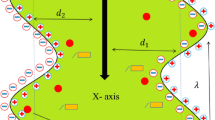Abstract.
The laminar flow dynamics and heat convection of copper-water nanofluid in a channel, under the wall heat flux and constant magnetic field, are studied. The presence of nanoparticles in the base fluid under the magnetic field in the developing channel region causes physical complexity. In this study, density, heat capacity, thermal expansion coefficient, electrical conductivity and viscosity of the nanofluid are considered as a function of the volume fraction of suspended nanoparticles in water. The thermal conductivity of the nanofluid is a function of temperature. Equations of continuity, momentum and the energy are solved by considering the Lorentz force generated by the magnetic field. The equations of the nanofluid flow are discretized and solved using the finite volume approach. The SIMPLE algorithm is employed to handle the pressure-velocity coupling for the continuity and momentum equations. In the absence of magnetic field, by adding 4% particle volume fraction of copper to the water, The Nusselt number is increased by about 14%. By applying the magnetic field, e.g., Hartmann number 20, with 4% volume fraction of nanoparticles, the Nusselt number increases about 15%. The results show that using the magnetic field helps the hydrodynamic development of the flow, so that by removing the magnetic field, the flow to the end of the channel is developing. It is observed that by applying the magnetic field in Hartmann numbers 5, 10 and 20, the flow is developed hydrodynamically at the dimensionless length x/D = 4.0, 1.0 and 0.5, respectively. By applying the magnetic field, the flow velocity is increased in the area around the walls and in the center of the channel becomes less, so that, the velocity profile becomes flattened. By flattening the velocity profile, velocity increases in areas around the walls and as a result, the heat transfer and Nusselt number increase. It can be also seen that on a fixed Hartman number, by decreasing the angle of the magnetic field relative to the direction of flow, the decrease of velocity starts at a smaller distance from the center of the channel. At angles 90° , 45° , 30° decrease of velocity, occurs at dimensionless distance, y/(D/2) = 0.8, 0.7 and 0.6, respectively.
Similar content being viewed by others
References
S.U. Choi, J. Eastman, Am. Soc. Mech. Eng. San Fr. 196525, 12 (1995)
A.K. Santra, S. Sen, N. Chakraborty, Int. J. Therm. Sci. 48, 391 (2009)
S.E.B. Maiga et al., Superlattices Microstruct. 35, 543 (2004)
G. Fabbri, R. Rossi, Int. Commun. Heat Mass Transfer 32, 902 (2005)
Y. Xuan, Q. Li, J. Heat Transf. 125, 151 (2003)
Q. Li, Y. Xuan, Sci. China Ser. E Technol. Sci. 45, 408 (2002)
M.K. Moraveji, M. Darabi, S.M.H. Haddad, R. Davarnejad, Int. Commun. Heat Mass Transfer 38, 1291 (2011)
W.Y. Lai, S. Vinod, P.E. Phelan, R. Prasher, J. Heat Transf. 131, 112401 (2009)
K.B. Anoop, T. Sundararajan, S.K. Das, Int. J. Heat Mass Transfer 52, 2189 (2009)
S. Tahir, M. Mital, Appl. Therm. Eng. 39, 8 (2012)
S. Kumar, S.K. Prasad, J. Banerjee, Appl. Math. Model. 34, 573 (2010)
M. Corcione, Heat Transf. Eng. 33, 575 (2012)
J. Buongiorno, J. Heat Transf. 128, 240 (2006)
M. Chandrasekar, S. Suresh, T. Senthilkumar, Renew. Sustain. Energy Rev. 16, 3917 (2012)
U. Müller, L. Bühler, M. Biology, Magnetofluiddynamics in Channels and Containers (Springer Science & Business Media, 2013)
J.P. Kumar, J.C. Umavathi, B.M. Biradar, Int. J. Nonlinear. Mech. 46, 278 (2011)
A.J. Chamkha, E. Abu-Nada, Eur. J. Mech. 36, 82 (2012)
S. Sivasankaran, A. Malleswaran, J. Lee, P. Sundar, Int. J. Heat Mass Transfer 54, 512 (2011)
M. Biglarian et al., Int. J. Hydrogen Energy 42, 22005 (2017)
N. Purohit, S. Jakhar, P. Gullo, M.S. Dasgupta, Renew. Energy 120, 14 (2018)
S. Patankar, Numerical Heat Transfer and Fluid Flow (CRC Press, 1980)
S.V. Patankar, D.B. Spalding, A calculation procedure for heat, mass and momentum transfer in three-dimensional parabolic flows, in Numerical Prediction of Flow, Heat Transfer, Turbulence and Combustion (Elsevier, 1983) pp. 54--73
M. Corcione, Heat Transf. Eng. 33, 575 (2012)
M. Sheikholeslami, D.D. Ganji, External Magnetic Field Effects on Hydrothermal Treatment of Nanofluid: Numerical and Analytical Studies (William Andrew, 2016)
R.K. Shah, A.L. London, Laminar Flow Forced Convection in Ducts: A Source Book for Compact Heat Exchanger Analytical Data (Academic Press, 2014)
L.M. Jiji, L.M. Jiji, Heat Convection (Springer, 2006)
Author information
Authors and Affiliations
Corresponding author
Additional information
Publisher’s Note
The EPJ Publishers remain neutral with regard to jurisdictional claims in published maps and institutional affiliations.
Rights and permissions
About this article
Cite this article
Fallahnezhad, N., Reza Nazif, H. Heat convection and hydrodynamic analysis of laminar developing nanofluid channel flow with variable properties under constant magnetic field and heat flux. Eur. Phys. J. Plus 134, 409 (2019). https://doi.org/10.1140/epjp/i2019-12787-6
Received:
Accepted:
Published:
DOI: https://doi.org/10.1140/epjp/i2019-12787-6




